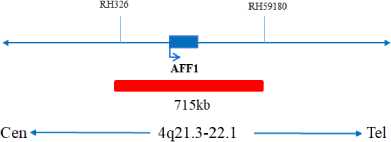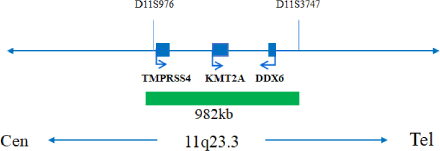Product Cat. No.: GBS-185
For Research Use Only.
KMT2A/AFF1 gene fusion probe reagent
10 Tests/box
This kit uses orange fluorescein to label AFF1 orange probe and green fluorescein to label KMT2A green probe. The KMT2A/AFF1 probes can be combined with the target detection site by in situ hybridization.
The kit consists of KMT2A/AFF1 dual color probe as shown in Table 1.
| Component name | Specifications | Quantity | Main components |
|---|---|---|---|
| KMT2A/AFF1 dual color probe | 100μL/Tube | 1 | AFF1 Orange probe ; KMT2A Green probe |


Keep sealed away from light at -20°C±5°C.The product is valid for 12 months. Avoid unnecessary repeated freezing and thawing that should not exceed 10 times. After opening, within 24 hours for short-term preservation, keep sealed at 2-8°C in dark. For long-term preservation after opening, keep the lid sealed at -20°C±5°C away from light. The kit is transported below 0°C.
Fluorescence microscopy imaging systems,including fluorescence microscopy and filter sets suitable for DAPI (367/452), Green (495/517),and Orange (547/565).
1. Applicable specimen type: unfixed fresh bone marrow specimen (stored at 2-8 °C for no more than 24 hours).
2. Sample collection take 1-3ml of bone marrow cells anticoagulated with heparin sodium.
3. Sample preservation: after fixation, the cell suspension shall be stored at -20±5°C for no more than 12 months; The prepared cell slides can be stored at -20±5°C for no more than 1 month. When the sample storage temperature is too high or too low, or the cell suspension is volatilized excessively or polluted during storage, the sample will not be used for detection.
1. 20×SSC, pH 5.3±0.2
Weigh 176g of sodium chloride and 88g of sodium citrate, dissolve in 800mL of deionized water, adjust the pH to 5.3±0.2 at room temperature, and complete to 1L with deionized water. High-pressure steam sterilization, stored at 2-8oC, the solution shelf life is of 6 months. Discard if the reagent appears cloudy (turbid) or contaminated.
2. 2×SSC, pH 7.0±0.2
Take 100mL of the above 20xSSC, dilute with 800mL deionized water, mix, adjust the pH to 7.0±0.2 at room temperature, complete to 1L with deionized water, stored at 2-8oC, the shelf life is of 6 months. Discard if the reagent appears cloudy (turbid) or contaminated.
3. Ethanol Solution: 70% ethanol, 85% ethanol
Dilute 700ml, 850ml of ethanol with deionized water to 1L. The shelf life is of 6 months. Discard if the reagent appears cloudy (turbid) or contaminated.
4. 0.3% NP-40/0.4xSSC solution, pH 7.0-7.5
Take 0.6mL NP-40 and 4mL 20×SSC, add 150mL deionized water, mix, adjust the pH to 7.0-7.5 at room temperature, with deionized water complete to a volume of 200mL. Stored at 2-8oC, the shelf life is of 6 months. Discard if the reagent appears cloudy (turbid) or contaminated.
5. Fixation solution (methanol: glacial acetic acid = 3:1)
Prepare a ready to use fixation solution by mixing thoroughly 30ml of methanol and 10ml of glacial acetic acid.
6. 0.075M KCl solution
Weigh 2.8g of potassium chloride, dissolve in 400mL of deionized water and complete to 500mL with deionized water. Stored at room temperature, the solution shelf life is of 6 months. Discard if the reagent appears cloudy (turbid) or contaminated.
7. Diamidinyl phenylindole (DAPI) counterstain
Use commercially available anti-quenching DAPI counterstain.
1. Sample collection and slides preparation
2. Slide pretreatment procedure
3. Denaturation and Hybridization
The following operations should be performed in a darkroom.
4. Washing
The following operations should be performed in a darkroom.
5. Counterstaining
The following operations should be performed in a darkroom
10μl DAPI compound dye is dropped in the hybridization area of the glass slide and immediately covered. The suitable filter is selected for glass slide observation under the fluorescence microscope.
6. FISH results observation
Place the counterstained film under the fluorescence microscope, and first put it under the low-power objective lens (10x) confirm the cell area under the microscope; Go to 40x under the objective lens,find a position where the cells are evenly distributed; Then in the high-power objective (100x) the FISH results of nuclei are observed.

Negative: 2 orange 2 green

Positive: 1 orange 1 green 2 fusion
1.The results of this kit will be affected by various factors of the sample itself, but also limited by hybridization temperature and time,operating environment and the limitations of current molecular biology technology, which may lead to wrong results.
2.Users must understand the potential errors and accuracy limitations that may exist in the detection process.
3.All chemicals are potentially dangerous. Avoid direct contact. Used kits are clinical waste and should be properly disposed off.
V1. 0: Approval date: April 01, 2019.
V1. 4: Revision date: September 21, 2022.
